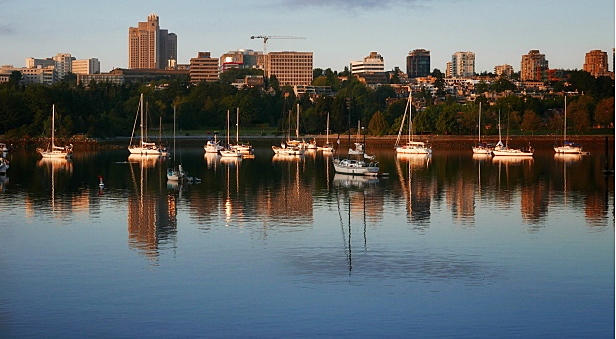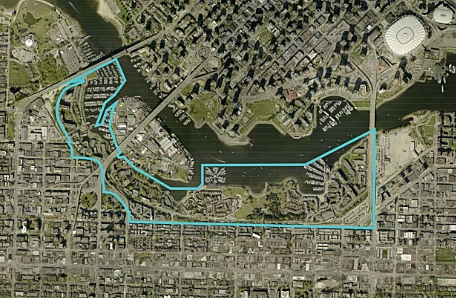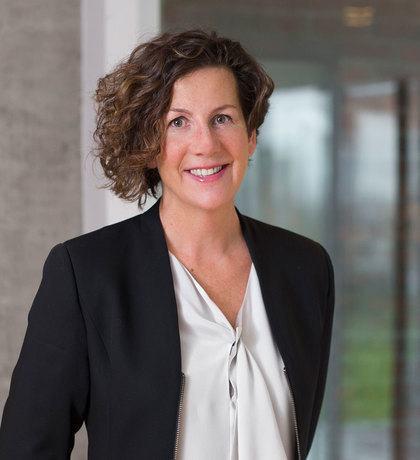With its mix of housing types, plentiful co-ops and highly walkable design, False Creek South is one of the most unique and affordable neighbourhoods in Vancouver — and the city wants to keep it that way.
Last week, city council voted unanimously in favour of a motion that will begin a long-term replanning effort for the centrally located neighbourhood, based on a set of guiding principles that aim to stick as close as possible to the original vision that has made it so successful.
"[This motion] confirms the original vision for False Creek South, which is a vision of a complete neighbourhood — one that offers a range of housing options that are affordable for a range of people," said Councillor Adriane Carr.
"That original concept of, let's create a place where people of any age, any background, any family status can afford to live there, and do so in a way that minimizes their need for cars — this is exactly the way we need to go in Vancouver right now."
The south shore of False Creek has changed drastically since redevelopment efforts began in the 1970s. (City of Vancouver)
Walter Hardwick's vision
False Creek South is a mainly residential neighbourhood that, as the name suggests, lies along the south shore of False Creek, between the Burrard Bridge to the west and the Cambie Street Bridge to the east.
A walk along the seawall that runs through the neighbourhood makes its uniqueness apparent: across the water, Yaletown glistens with high-rise condo towers, but False Creek South is comprised largely of stacked townhouses — many of them quite large, and thus suitable for families — arranged in "enclaves" with central courtyards.
The area also features a diverse range of housing types, from privately owned market rental to affordable housing co-ops and everything in between.
The neighbourhood was first envisioned in the 1970s as a way to revitalize the city's run-down industrial waterfront. It was spearheaded by Walter Hardwick, a councillor at the time who also led the charge to stop a proposed freeway system that would have drastically changed the face of downtown Vancouver.
FROM THE ARCHIVES | How Granville Island changed the course of Vancouver urban design history
"It was really born of that activism in stopping the freeway that got people thinking about, you know, what do you want at the core of a city if it's not freeways?" said Carr, who completed her master's degree as a student of Hardwick's.
"And the answer was we want people living at the core of the city — people living affordably in neighbourhoods where they don't need cars."
The neighbourhood of False Creek South, as defined by the City of Vancouver. (City of Vancouver)
Lease deadlines closer than they appear
One of the main reasons the neighbourhood has stayed so affordable is that many of the co-ops are on long-term leases on city-owned land. The majority of those leases come due in 2036 or later, but some come due as early as 2022 — less than five years away.
Uncertainty around what will happen when those leases are renegotiated is a major concern for residents in the area, says Richard Evans, chair of the False Creek South Neighbourhood Association's *RePlan committee — specifically, whether they will be able to afford to remain in the neighbourhood, as land values have skyrocketed since the 1970s.
"Now we're seeing words from the city that are actually starting to address some of those basic concerns," Evans said. "Those kinds of words are really helpful in speaking to what people's concerns have been."
Though many of the lease due dates are nearly 20 years away, Evans said they're still a concern for residents — especially individuals and stratas looking to take out mortgages, as most banks only offer terms of five years less than the term of the lease.
"It seems like a long way out, but it's really an issue that's very pertinent for a lot of people right now," Evans said.
Much of False Creek, including Granville Island, was redeveloped in the 1970s as part of an effort to revitalize a stagnating industrial wasteland. (CBC archives)
Future unclear, but city and residents hopeful
Though the city seems committed to keeping the core of what has made False Creek South a success intact, it will be a lengthy process of research, consultation and negotiation before any decisions are made.
But Carr is hopeful that the neighbourhood can remain a model for successful community planning for decades to come.
"For me, it's really exciting to be thinking about us maintaining the original vision of False Creek being this highly livable, highly affordable, very socially well-connected community," Carr said.
"The pressure is always to develop more densely within Vancouver, and there's way too many condos, in my mind, that end up not being affordable for the people who work and live here now."
If anything, False Creek South has become a bit of a victim of its own success. Waiting lists for many of the co-ops in the neighbourhood are upwards of three years, and many have closed their waiting lists altogether.
Evans is hopeful that solutions can be found, and that lessons learned in False Creek South can be applied to Vancouver's broader housing crisis.
"The indication is that what we have going there now is working," Evans said. "So [what we do going forward] is kind of a litmus test, I think. It'll be interesting in the next couple years to find out how we handle this."


